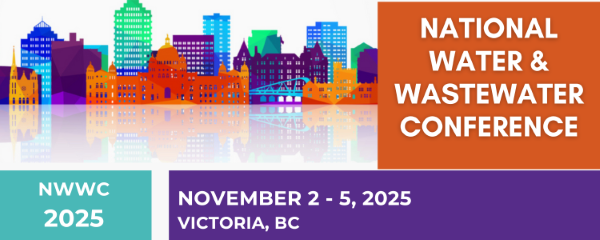Well, I hope everyone had as great a summer as I did. Nothing big, no big trips. But it was filled with extended weekends, friends’ cottages, weddings, and family reunions—then lots of swimming, kayaking, and cycling (to a local brewpub or two J). I hope everyone reading this escaped the wildfires unharmed and survived the prolonged heat waves.
|
Municipalities across Canada decide whether or not to add fluoride to the drinking water supply delivered to their residents. It is a decision to be made by the municipal council or by a provincial/territorial health authority. This decision is made with direction from the local health authority and following extensive public engagement. The purpose of this CWWA Fact Sheet and Speaking Notes is to help municipal water officials brief their Councils and other stakeholders on the topic of fluoridation of drinking water.
|
The National Water and Wastewater Conference is THE event for water utility managers. August 31 is the last day to register at the early bird rate or to secure the best prices on our exhibitor opportunities.
You know you're a dedicated CWWA employee when you wear your CWWA hat in 40 degree temperatures at the Roman Collosseum (and get your teenage daugher to join in too). Kara and Avery Parisien
|
At the Canadian Council of Ministers of the Environment meeting, environment ministers endorsed new ambient air quality standards for fine particulate matter and discussed the nexus of contaminated sites, climate change, and reconciliation. They acknowledged the impact of wildfires on air quality and the role of extended producer responsibility (EPR) in waste management, emphasizing collaboration across governments and with Indigenous partners. The presidency of CCME transitioned from Northwest Territories to Alberta for the 2026 meeting. A separate session with Indigenous leaders focused on site remediation, climate change, and economic opportunities for Indigenous communities took place.
|
The Government has issued a new interim order Respecting the Discharge of Sewage and the Release of Greywater by Cruise Ships in Canadian Waters. It prohibits the discharge of sewage and release of greywater within three nautical miles of shore. Beyond three nautical miles, discharges are permitted only if they meet specific treatment and water quality standards. Ships must maintain detailed records, conduct effluent testing when required, and hold appropriate certificates. While not directly relevant, it always interesting to see how effluent is regulated from other sectors.
|
 
|

|

The UMWEF Poster Competition is the first poster contest organized by the University of Manitoba Student Chapter of the Water Environment Federation (UMWEF). The competition provides students and young professionals with the opportunity to showcase their research, exchange ideas, and network with professionals. The UMWEF Poster Competition will occur during the 2025 Canadian Residuals & Biosolids Conference, organized by the Western Canada Water Environment Association (WCWEA).
|
The B.C. government is investing over $6 million in 11 community projects to enhance protection against natural and climate-driven hazards. The Disaster Resilience and Innovation Funding (DRIF) program is supporting First Nations and local governments in implementing projects to mitigate risks. The Village of Hazelton is receiving $3.6 million from DRIF, with an additional $6.4 million from the Province, for a $10-million dike project along the Skeena River to reduce flood risk. Other projects include a flood-hazard assessment by Homalco First Nation, a water intake dam design for Kitasoo Xai'xais Nation, and a flood-risk management strategy by Whispering Pines/Clinton Indian Band.
|
 
|

|

ES&E Magazine
Governments around the world are using regulation to reduce the risk of human exposure to the harmful effects of PFAS. By setting limits on the permissible levels of these compounds in drinking water, regulators are forcing water suppliers to undertake advanced treatment to ensure compliance.
|
European Commission
Europe’s water is already under pressure from climate change, surging demand and crumbling infrastructure — not to mention the dangers of chemical pollution. We meet the LIFE projects keeping our water supplies clean and safe.
|
ES&E Magazine
Metro Vancouver’s Board of Directors has determined that a review of the North Shore Wastewater Treatment Plant Program is “not in the public interest” while the region remains involved in litigation with former project contractor Acciona.
|
ES&E Magazine
“What can we do to make up for what we didn’t do, when nobody was doing it?” asks Darlene Conway, a senior engineer with Ottawa’s Stormwater Management Branch, as she co-leads a tour of the city’s newest stormwater project.
|
CNN
Melissa Mays said she may never trust the water from her Flint, Michigan, tap again.
In the 11 years since the city’s historic water crisis, Mays said she has battled Legionnaires’ disease, autoimmune and seizure disorders, high blood pressure, and other illnesses. Her youngest son, now 21, experienced speech delays as a child after unknowingly drinking lead-poisoned water, she added.
|
World Economic Forum
Water is becoming a significant geopolitical risk, as scarcity and unequal access to water contribute to rising political tensions. When demand exceeds supply, competition over transboundary rivers, reservoirs and aquifers intensifies, adding pressure in already fragile regions.
|
 
|

|

16
Sep 2025
|
Toronto Metropolitan University
Through presentations and roundtable discussions, participants will explore current policies, what is on the horizon, and economic and policy levers from other jurisdictions.. Collaborate with leaders from government, industry, and academia to develop actionable recommendations for government decision-makers.
|
5
Oct 2025
|
St. John’s Newfoundland, NL
|
2
Nov 2025
|
CWWA's national conference featuring presentations from water and wastewater experts from across the country!
|
|













 National Water & Wastewater Conference
National Water & Wastewater Conference